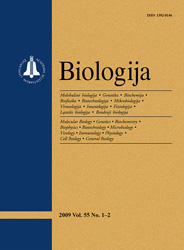 ISSN 1392-0146 ISSN 2029-0578 (online) |
2008 m. Nr. 1 Cenosis structure and species composition dynamics of micromycetes decomposing crop root residues in soil
Experiments on the decomposition of crop residues were carried out at the Experimental Station of the Lithuanian University of Agriculture (54°53’N, 23°50’E) in a model field in 2004–2006. The soil of the experimental site is Endocalcari-Epihypogleyic Cambisol (sicco) (CMg-p-w-can). We investigated root residues of winter oilseed rape (Brassica napus L. ssp. oleifera biennis Metzg.), spring oilseed rape (Brassica napus L. ssp. oleifera annua Metzg.), winter wheat (Triticum aestivum L.), and red clover (Trifolium pratense L.) decomposed in soil for different time (7.5, 14.5, 19.5, and 26.5 months). The aim of the investigation was to establish in soil decomposed winter and spring rape root micromycetes community structure and species composition dynamics in comparison with winter wheat and clover roots. It has been established that on the decomposed crop roots micromycetes spread depended first of all on the plant species. Most of micromycetes colony forming units were found on red clover roots, less on rape roots and least on winter wheat roots. The micromycetes colony forming unit number depended on root decomposition (according to correlative-regressive analysis a positive strong and very strong correlation) and on the decomposed substrate C : N ratio (a strong and very strong negative correlation). A specific character of the genus Trichoderma fungi species spreading depending on the nature of crop roots has been established. For the first time in Lithuania the following species have been identified: T. longibrachiatum – on winter and spring rape, T. aggressivum f. europaeum – on winter rape, T. spirale – on spring rape, winter wheat and clover, T. crassum – on winter wheat and winter rape, T. brevicompactum – on winter wheat roots. On the decomposed rape roots Trichoderma micromycetes producing antibiotics were prevailing (T. harzianum, T. aggressivum f. europaeum, T. viride, T. hamatum and others) and limited the development of conditionally phytopathogenic Fusarium, Rhizoctonia, Penicillium, Alternaria and other fungi. In all periods of study, on rape roots the number of Fusarium species was lower than on clover or wheat roots. Thus, Trichoderma fungi abundance on rape residues, rape root chemical composition and the peculiarities of their fragmentation products are important factors influencing the phytosanitary state of soil. Keywords: crop root residues, decomposition, micromycetes, carbon and nitrogen ratio |
Issues:
2011 - Vol.57 No. 1, No. 2, No. 3 2010 - Vol.56 No. 1-4 2009 - Vol.55 No. 1-2, No. 3-4 2008 - Vol.54 No. 1, No. 2, No. 3, No. 4 2007 - Vol.53 No. 1, No. 2, No. 3, No. 4 2006 No. 1, No. 2, No. 3, No. 4 2005 No. 1, No. 2, No. 3, No. 4 2004 No. 1, No. 2, No. 3, No. 4 2003 No. 1, No. 2, No. 3, No. 4 2002 No. 1, No. 2, No. 3, No. 4 2001 No. 1, No. 2, No. 3, No. 4 |